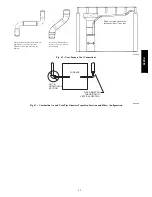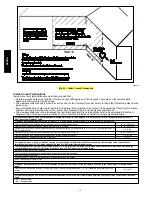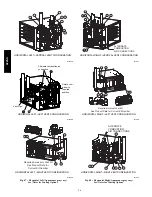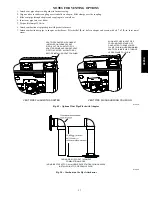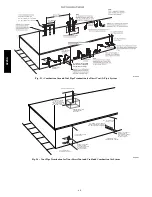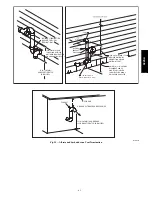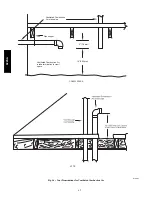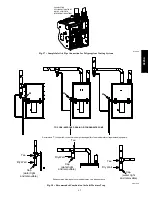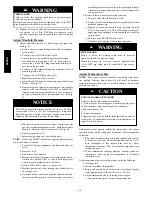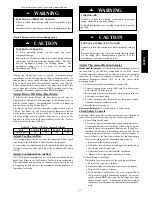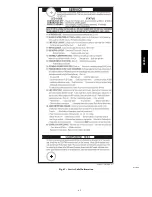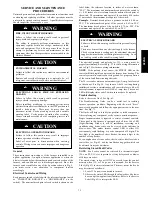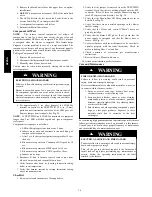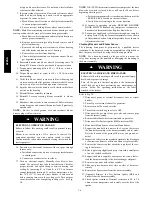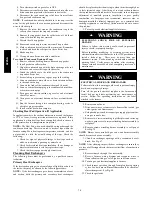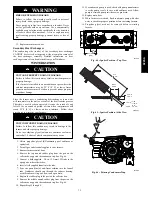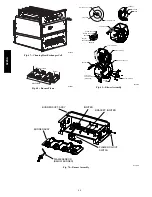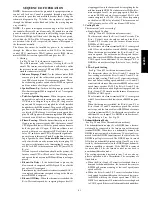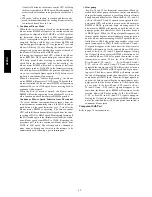
67
S
Decrease blower speed to increase temperature rise.
ELECTRICAL OPERATION HAZARD
Failure to follow this warning could result in personal injury
or death.
Disconnect 115vac electrical power before changing speed tap.
!
WARNING
(Read following caution before changing taps).
UNIT DAMAGE HAZARD
To avoid operating outside the rise range and avoid
component damage:
Refer to the Air Delivery Tables to determine which airflows
and settings are allowed for proper heating airflow. DO NOT
use the highlighted settings for Heating airflow.
The
highlighted settings are to be used for Cooling and
Continuous Fan ONLY.
CAUTION
!
Change the blower heat taps as required to maintain proper
temperature rise for Heating and Cooling as described above. To
change blower motor speed selections for heating mode, remove
blower motor lead from control HEAT terminal. See Fig. 38.
Select desired blower motor speed lead from one of the other
motor leads and relocate it/them to HEAT (heating blower tap)
terminal(s). Reconnect original lead on SPARE terminal.
Adjust Blower Off Delay (Heat Mode)
If desired, the main blower off time delay period may be
lengthened or shortened when operating in the heating mode to
provide greater comfort. For position and location of jumpers on
control center, see Fig. 38 and Fig. 72.
The blower off delay has four adjustable settings from 90 sec to
180 sec. See Table 18. The blower off delay jumpers are located
on the furnace control See Fig. 38 and 72. To change the blower
off delay setting, move the jumper from one set of pins on the
control to the pins used for the desired blower off delay. Factory
blower off delay setting is 120 sec.
Table 18 – Blower Off Delay Jumper Positions
PINS
1 AND 2
2 AND 3
3 AND 4
4 AND 5
Time (in sec.)
90
120
150
180
Adjust Cooling Airflow
The cooling airflow can be set from the remaining blower speed
taps. Refer to the Air Delivery Tables in these instructions.
If a two--stage air conditioning or heat pump is installed, the Low
Cooling Speed is the same speed tap as the Continuous Fan speed
(FAN).
Adjust Continuous Fan Airflow
The Continuous Fan airflow can be set from the remaining blower
speed taps. Refer to the Air Delivery Tables in these instructions.
The Continuous Fan speed can be changed to any other speed tap
by toggling the Fan switch at the thermostat. See the Sequence of
Operation for details.
FIRE HAZARD
Failure to follow this warning could result in personal
injury, death, and/or property damage.
Reinstall manifold pressure tap plug in gas valve to prevent
gas leak.
!
WARNING
FURNACE OVERHEATING HAZARD
Failure to follow this caution may result in reduced furnace
life.
Recheck temperature rise. It must be within limits specified
on the rating plate. Recommended operation is at the
mid--point of rise range or slightly above.
CAUTION
!
Adjust Thermostat Heat Anticipator
Mechanical thermostat
: Set thermostat heat anticipator to match
the amp draw of the electrical components in the R--W circuit.
Accurate amp draw readings can be obtained at the wires normally
connected to thermostat subbase terminals R and W.
The
thermostat anticipator should NOT be in the circuit while
measuring current.
1. Remove thermostat from subbase or from wall.
2. Connect an amp meter across the R and W subbase termi-
nals or R and W wires at wall.
3. Record amp draw across terminals when furnace is in low
heat and after blower starts.
4. Set heat anticipator on thermostat per thermostat instruc-
tions and install on subbase or wall.
5. Install blower access door.
Electronic thermostat
: Set cycle rate for 3 cycles per hr.
Check Safety Controls
The flame sensor, gas valve, and pressure switch were all checked
in the Start--up procedure section as part of normal operation.
1. Check Main Limit Switch
This control shuts off combustion system and energizes air--
circulating blower motor, if furnace overheats. By using this
method to check the temperature limit control, it can be es-
tablished that the limit is functioning properly and that the
limit will operate if there is a restricted return--air supply or
motor failure. If the limit control does not function during
this test, the cause must be determined and corrected.
a. Run furnace for at least 5 minutes.
b. Gradually block off return air with a piece of cardboard or
sheet metal until the limit trips.
c. Unblock return air to permit normal circulation.
d. Burners will re--light when furnace cools down.
2. Check Pressure Switch(es)
This control proves operation of the draft inducer blower.
a. Turn off 115--v power to furnace.
b. Disconnect inducer motor lead wires from wire harness.
c. Turn on 115--v power to furnace.
d. Set thermostat to “call for heat” and wait 1 minute. When
low pressure switch is functioning properly, hot surface
igniter should
NOT
glow and control diagnostic light
flashes a status code 31. If hot surface igniter glows when
inducer motor is disconnected, shut down furnace immedi-
ately.
922SA

